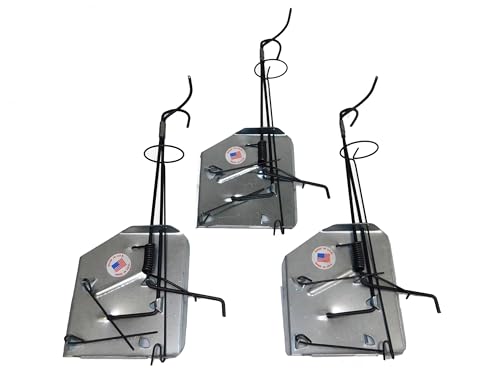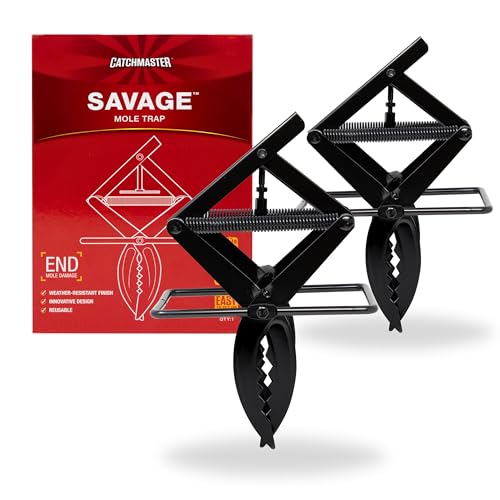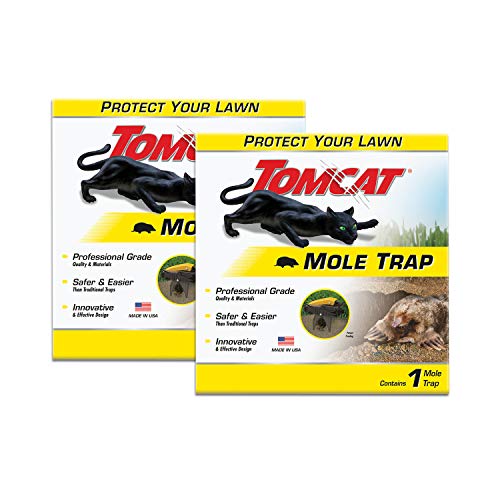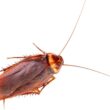Moles can turn a beautiful lawn into a nightmare of tunnels and dirt mounds almost overnight. These tiny underground diggers can create over 150 feet of tunnels in a single day, leaving homeowners frustrated with damaged grass and unsightly molehills everywhere.
The good news? Trapping remains the most effective way to get rid of moles for good. Unlike repellents or home remedies that rarely work, the best mole traps can solve your problem quickly and permanently. The key is choosing the right trap and using it correctly.
1. Wire Tek 1001 EasySet Mole Eliminator Trap
- Heavy-gauge steel construction, made in the USA for durability and quality.
- Easy foot-stepping setup with no digging required, installs directly in mole tunnels.
- Works best in soft soil, sand, or mulch; simple soil prep needed for harder ground.
- Humane mole control, safe for use on organic farms and gardens.
This American-made trap tops the list because it combines power with simplicity. The heavy-gauge steel construction means it will last for years, while the unique foot-step setting system makes it incredibly easy to use.
What sets this trap apart is that you don’t need to dig holes or use your hands to set it. Simply step on the lever to arm the trap safely. The design works great in soft soils like sand and mulch, and it’s completely chemical-free, making it safe for organic gardens.
The trap uses no bait and kills moles instantly when they pass through their tunnels. Many users report catching moles within hours of setting it up.
2. Victor 0631 Out O’Sight Mole Trap
- Professional-grade mole trap trusted by pest control experts.
- Works in all soil types and eliminates moles quickly.
- Durable iron construction for long-lasting, repeated use.
- Below-ground design keeps trap concealed and effective.
The Victor trap has been a favorite among homeowners for decades. This scissor-style trap features spring-loaded blades that snap shut when triggered, providing a quick and humane kill.
Built from water-resistant iron, this trap can handle rain and moisture without rusting. The underground operation keeps it hidden from view and safe around pets and children. Safety clips and setting levers give you complete control during setup.
This model works well in most soil types and is particularly effective for people who want a proven, time-tested design.
3. CINCH Traps Mole Kit
- Professional-grade design delivers effective gopher elimination.
- Heavy-duty, reusable, and weather-resistant for long-term use.
- Ideal for lawns, gardens, ranches, and sports fields.
- Precision trapping technology ensures a humane, powerful kill.
This complete starter kit includes everything needed for successful mole trapping. You get two handmade galvanized steel traps, yellow lawn flags for marking locations, and detailed instructions.
The traps come in multiple sizes (small, medium, large) to fit different tunnel diameters. A unique feature lets you check if the trap has been triggered without removing the mole, making monitoring simple and clean.
CINCH traps are known for their quality construction and homeowner-friendly design. The included instructional materials help beginners get started quickly.
4. GopherHawk Trapping Set
- Includes trap, wedge, and probe tool for easy setup.
- Installs without digging or disturbing your lawn or garden.
- No poisons or bait required for safe gopher control.
- Bright yellow stripes signal when the trap is activated.
This professional-grade set includes specialized probe tools along with the trap, making it easier to locate active tunnels. The design works well for large properties or areas with multiple mole problems.
Installation requires no digging, and the trap features rust-resistant properties for long-term outdoor use. The set approach means you have all the tools needed for successful mole control in one package.
Many users appreciate the included probe tools, which help identify the best trap placement locations.
5. Catchmaster Savage Professional Strength Easy Set Mole Trap
- Heavy-duty metal construction with reinforced jaws for effective mole control.
- Easy-to-set, fast-acting plunger-style design for quick results.
- Reusable and weatherproof for long-term outdoor use.
- Targets active mole tunnels without the need for chemicals or poisons.
This heavy-duty trap features weatherproof construction designed for repeated use. The reinforced jaws increase trapping success rates compared to lighter models.
The easy-set design saves time when placing multiple traps around a property. Since it requires no bait, setup is clean and straightforward. This makes it one of the best mole traps for people who need quick, efficient results.
The professional-strength construction means it can handle tough soil conditions while maintaining sensitivity to mole movement.
6. Tomcat Mole Trap
- Heavy-duty, dual-spring design for effective mole elimination.
- Curved jaws capture and kill quickly without drawing blood.
- Hands-free, step-to-set mechanism for easy placement.
- Durable and reusable, ideal for repeated mole control.
The Tomcat trap stands out for its clean-kill design that eliminates moles without drawing blood. This makes disposal easier and the trap simpler to clean for reuse.
The low-profile design sits close to ground level, making placement and setup simple. The trap can be safely disengaged and moved to different tunnels if needed, and it doesn’t have bulky parts that can cause injuries during handling.
This model works well for homeowners who want an effective trap that’s also easy to manage and maintain.
7. Trapline Mole Traps
These stainless steel traps are built for serious mole problems. They’re placed directly into the tunnel system and feature a durable construction that won’t rust even after years of use.
Trapline traps work by creating a choker loop that catches moles as they travel through their tunnels. The stainless steel construction means they’ll look like new even after five years of use.
Professional pest control companies often choose this brand because of its reliability and effectiveness in various soil conditions.
Types of Mole Traps Explained
Understanding different trap types helps you choose the right tool for your situation. Each style has specific advantages depending on your needs and experience level.
Scissor Traps use spring-loaded jaws that snap shut when a mole passes through. These are the most common type found in stores and work well for beginners. They’re placed directly in mole tunnels and are effective in most soil types.
Tunnel Traps (also called choker traps) feature an enclosed box with wire loops. When triggered, the loops catch the mole around the body. Professional mole catchers often prefer this style because of its high success rate.
Harpoon Traps work by driving spikes downward into tunnels when triggered. They’re designed for surface tunnels and are easy to set, but they work best in shallow tunnel systems.
Live Catch Traps capture moles without harming them, allowing for relocation. These require more frequent checking and aren’t always successful since moles may not survive relocation.
How to Choose the Right Mole Trap
Several factors should guide your trap selection. Soil type plays a big role in trap effectiveness. Sandy or loose soils work well with most trap styles, while rocky or clay soils might need heavier-duty models.
Safety considerations matter if you have pets or small children. Underground-striking traps and tunnel-style models reduce surface-level risks compared to spring-loaded designs.
Consider the size of your mole problem. A single mole can create extensive damage, but larger infestations might benefit from trap kits with multiple units. The best mole traps for serious problems often come in sets.
Budget and durability needs also matter. Quality traps cost more upfront but last for years and have higher success rates than cheap alternatives.
When to Set Mole Traps
Timing can make the difference between success and frustration. Spring and fall are the best seasons for mole trapping because these animals are most active during these periods.
In spring, moles emerge from deep winter tunnels and increase their feeding activity. This makes them more likely to encounter traps. Fall brings another peak as moles prepare for winter by intensifying their tunneling.
Early morning and evening hours see the most mole activity. Setting traps during these times or checking them at these periods can improve success rates.
Weather conditions also matter. Moist soil after rain makes tunneling easier for moles, increasing their surface activity. Dry or frozen ground drives moles deeper, making traps less effective.
How to Set Mole Traps Successfully
Proper setup is crucial for trap success. Start by identifying active tunnels using the stomp test. Step gently on a raised tunnel section and mark the spot. If the tunnel is rebuilt within 24 hours, it’s active.
Look for straight tunnel sections rather than curves or intersections. Moles travel faster through straight areas, making trap triggers more reliable.
Always wear gloves when handling traps. Moles have an excellent sense of smell and will avoid tunnels that smell like humans. Clean traps with soil before setting them to remove any foreign odors.
Follow manufacturer instructions carefully for each trap type. Proper placement depth and trigger sensitivity are critical for success. Most of the best mole traps work best when placed in the most frequently used tunnel sections.
Check traps daily and be patient. Moles are creatures of habit but may not use specific tunnels every day. It can take several days or even weeks to catch elusive moles.
Common Mole Trapping Mistakes
Many people fail at mole trapping because they make predictable errors. The biggest mistake is setting traps in inactive tunnels. Not all tunnels get regular use, so the stomp test is essential.
Not wearing gloves when handling traps leaves human scent that moles will detect and avoid. This simple oversight can make even the best mole traps completely ineffective.
Poor trap placement is another common error. Traps need to be positioned correctly in tunnels with proper depth and alignment. Rushing the setup process often leads to missed opportunities.
Giving up too early frustrates many homeowners. Mole trapping requires patience, and success may take days or weeks depending on mole behavior patterns.
Using cheap, low-quality traps saves money upfront but often leads to failure. Weak springs, poor materials, and bad design make budget traps ineffective and sometimes inhumane.
Professional vs DIY Mole Trapping
Professional mole control services cost more but bring expertise and guaranteed results. Professionals know how to read mole signs, place traps optimally, and handle multiple-mole situations.
DIY trapping works well for single-mole problems and saves money. With the right traps and proper technique, most homeowners can achieve success. The best mole traps available to consumers are nearly as effective as professional equipment.
Consider professionals for large properties, severe infestations, or situations where DIY attempts have failed repeatedly. They also handle disposal and follow local regulations automatically.
Alternative Mole Control Methods
While traps remain most effective, other methods exist with varying degrees of success. Castor oil-based repellents show some promise but rarely provide complete control.
Many people try controlling grubs to eliminate mole food sources. However, moles primarily eat earthworms, not grubs, so this approach usually fails.
Sonic devices and vibrating stakes claim to drive moles away through underground vibrations. Research shows these methods have limited effectiveness and may only temporarily relocate moles.
Poison baits exist but create risks for pets, children, and other wildlife. The best mole traps avoid these dangers while providing more reliable results.
Making Your Choice
The best mole traps combine effectiveness, safety, and ease of use. For most homeowners, scissor-style traps like the Wire Tek or Victor models provide the best balance of these factors.
Professional-grade options like CINCH or Trapline traps work well for serious infestations or people with extensive properties. These models cost more but deliver superior performance and durability.
Remember that success depends as much on proper technique as trap quality. Even the best mole traps won’t work if placed incorrectly or in inactive tunnels.
Start with one or two quality traps rather than buying many cheap ones. Learn proper placement and timing techniques, and be patient with the process. Most mole problems can be solved with persistence and the right approach.








